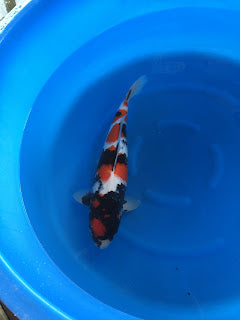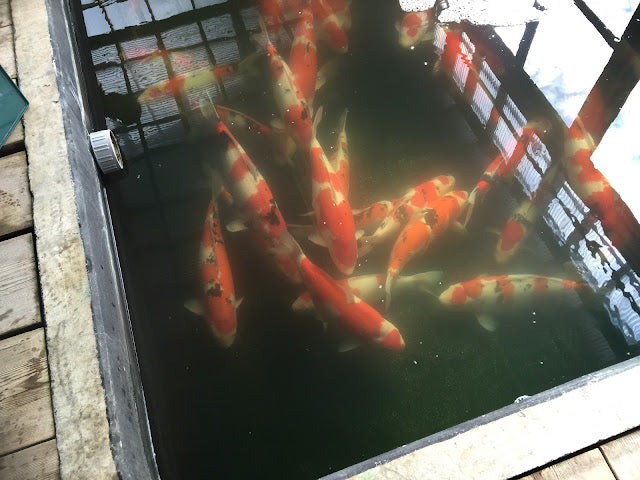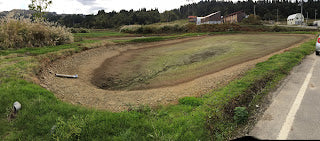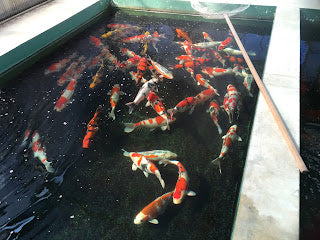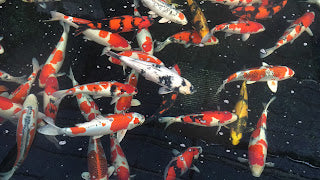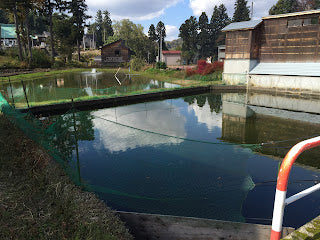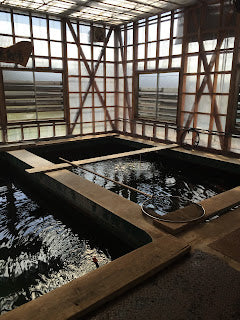My sister in law lives in Tokyo and I arranged to stay with her on Monday night, before flying out the next morning.
The plan was to reach her by 7pm to leave some time for catching up and to sample Tokyo life in her local area. and working back from that - we could achieve a decent stint in the mountains, heading back to Nagaoka station at around 3pm so I could catch the 4.12 pm Shinkansen train.
Breakfast at the New Otani turned out to be a good time for catching up with other koi people from around the world, the so-called, "koi kichi". And on Monday morning, I bumped into yet another person I've been meaning to catch up with for some time - Tony Pitham of Koi Water Barn. He shared some koi tips and experiences from a koi breeding project he ran some years ago in South Africa which has given me a few ideas for my own project next year. Thank you Tony!
We headed over to Shintaro for our first stop as Seth Alden , who is one of the guys we got to know over the last few days, offered to show us some koi he has growing on at the farm.
These are some of Shintaro s tosai growing on tanks and later in the day, we popped back and I took some footage of the tosai for my records. I will study the video over the winter to try and gleam ideas on what to select in for winter growing on .
Netting up Seth's fish:
This was also a great opportunity for me to have a fresh look at his fish house now that I have my eye in, and also see some more koi up close in an inspection bowl.
One of Seth's koi was in the tank with the big girls, and it as Shintaro was netting up the fish, it gave me a chance to take some pics of the big girls:
We've seen very few sanke on our trip so far , except for at a handful of farms. This has been one of the most suprising aspects of the trip , as with sanke occupying the number 2 spot in the go sanke varieties behind only kohaku , I'd expect to see them all over Niigata and in reasonable numbers.
Shintaro is known for his sanke and he didn't disappoint . I found the sanke big girls amonst the most enjoyable to view though the whole trip.
With the arrival of some customers, we made an exit and left them to it.
There is a koi farm we were keen to get to on a different part of the mountain and that we'd struggled to find so far. Gary has a directory of all the koi farms in Japan and the sat nav in the car works by entering the phone number of your destination. That worked for most koi farms, but not the one we were looking for , which was Koda koi farm.
In the directory, there's a page for each koi farm that looks like this :

At the bottom of each page is a small section of map which shows the location of the farm. We worked out that there were around half a dozen farms close enough to Koda that they all had the same small map section and were located on the adjoining roads. We tried each of these farms on the sat nav hoping that if the computer found one - it would get us in the area and we could navigate ourselves to the other 5 farms just using the maps. And as luck would have it - the sat nav recognised one and off we went :-)
On the way, we passed Miyatora which was one of the half a dozen in the area and we pulled up to have a look around.
At most of the koi farms we've been to so far, there are no mud ponds near the main outlet - but there were lots of mud ponds around Miyatora s premises ; whether they belong to Miyatora or another farm... I don't know.
We saw some nice mix of koi in the tanks, and some interesting metallic utsuri varieties including a metallic shiro utsuri ! Not seen one of those before! I've really enjoyed that aspect of the trip - seeing varieties of koi that I've not seen before. You don't need to buy anything to get pleasure from just looking... and admiring the work of the koi farmer.
After Miyatora, we were on manual navigation mode! And the next farm we passed was Chogorou. A man drove past in a small pickup truck with a range of koi farm paraphernalia on the back - and he waved with a warm 'hello'. A quick look at the koi farm directory, and we identified his as the owner, and just left us to have a look around. The premises were small and he must have other koi houses with his larger stock - as all we found were small tosai which just have been from this years spawnings
And there were some ponds adjoining the fish house . You can see the agitation of the water on the second pond, which is made mechanically by a paddle rotating through the water.
His koi house was very neat and tidy
Chogorou is famed for his platinum ogon; just like Izumiya is for Yamabuki or Omosako for shiro. And seeing a tank of platinum babies - we knew we were in the right place.
There was a second tank with quite an eclectic mix of varieties . And it will be interesting to see how these develop into full blown tosai and nissai next year.
He is famed for having one of the oldest lines of sanke, and we'd clearly got to him at the wrong time because the tanks were only sparesly populated and the water level was very low. We did see some interesting examples of sanke though ..
They kindly put koi socks over the water outlets to allow the pond surface to settle on each pond we moved to so we could see the fish better . The water was a little murky and difficult to get pictures there - but I can report they had some examples of long fin koi. Not my cup of tea at all, and I find them odd looking. But if you are into long finned koi, then you'd have enjoyed seeing the examples at this farm.
Other than that, a wide range of varieties of normal koi. We didn't spend long there - just a quick look around, to leave some dealers in peace as they negotiated over stock purchases.
And that was it, we had maximised the day and all that was left to do was to head back Nagaoka station and jump on the Shinkansen to Tokyo, before the long trip home.
Niigata has been quite the experience, and it's going to take some time for it all to sink in.






